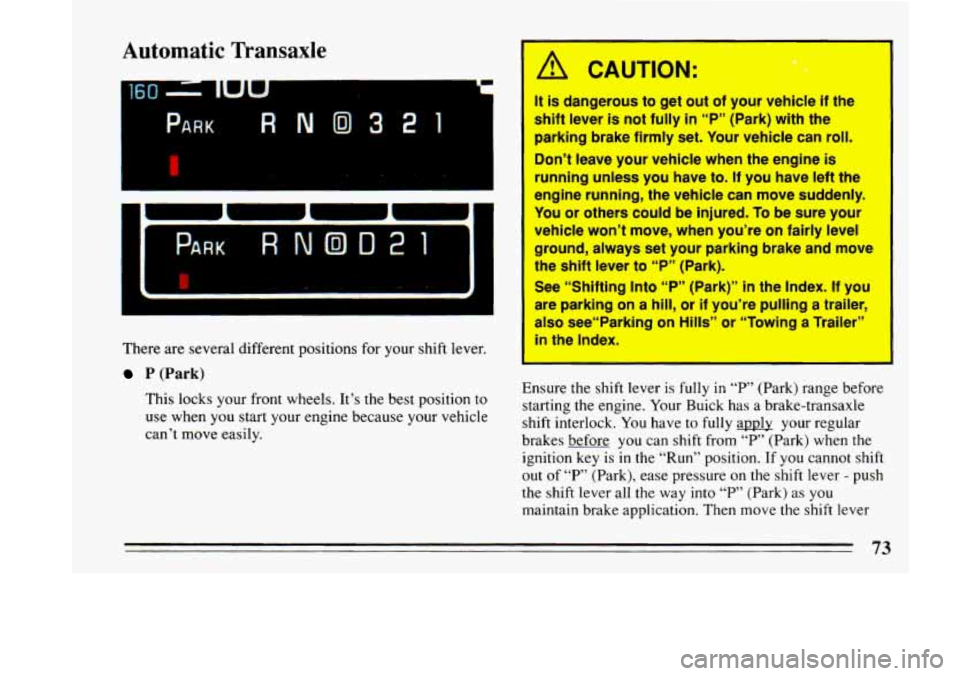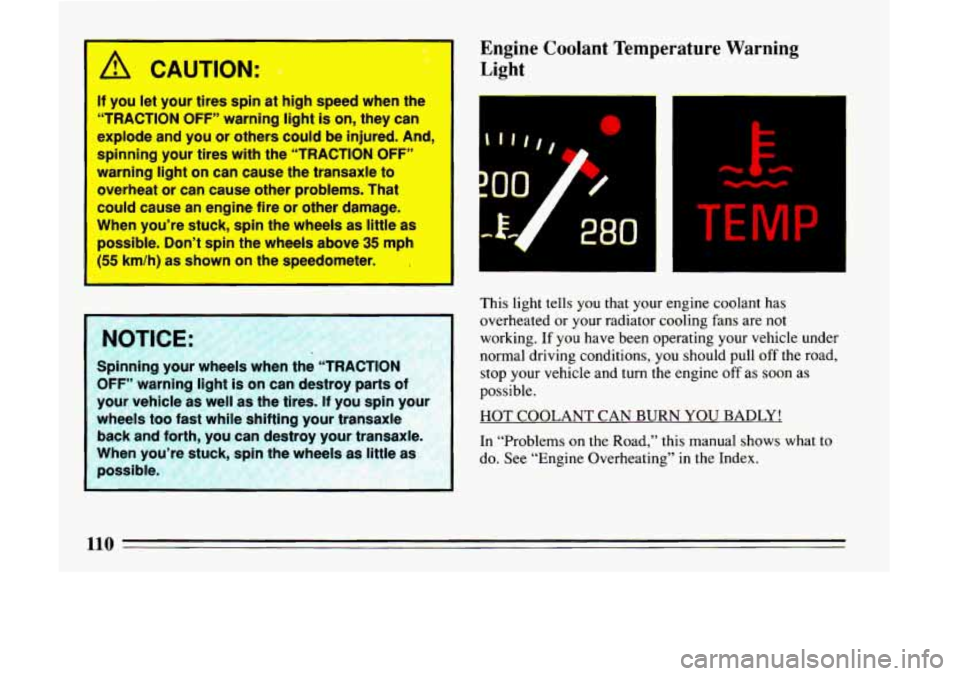Page 75 of 324

PARK RNO321
Automatic Transaxle
r
There are several different positions for your shift lever.
P (Park)
This locks your front wheels. It’s the best position to
use when you start your engine because your vehicle
can’t move easily.
A CAUTION: .
a -II
It is dangerous to get out of your vehicle If the
shift [ever is not fully in “P” (Park) with the
parking
brake firmly set. Your vehicle can roll.
Don’t leave your vehicle when ihe engine is
running unless you hsve to. If you have left the
engine
running, the vehicle can move suddenly.
You or others could be Injured. To be sure your
vehicle won’t move, when you’re on fairly level
ground, always set your parking brake and move
the shift lever to V“ (Park).
See “Shifting Into “P” (Park)” in the Index. If you
arb parkfng on a hill, or if you’re pulling a trailer,
also see“Parking on Hills” or “Towing a Trailer”
in’ the Index.
- i
Ensure the shift lever is fully in “F‘” (Park) range before
starting the engine. Your Buick has a brake-transaxle
shift interlock.
You have to fully apply your regular
brakes before
you can shift from “P” (Park) when the
ignition key is
in the “Run” position. If you cannot shift
out of “P” (Park), ease pressure on the shift lever - push
the shift lever all
the way into “P” (Park) as you
maintain brake application. Then move the shift lever
73
Page 76 of 324

into the gear you wish. See “Shifting Out of ‘P’ (Park)”
in this part.
R (Reverse)
Use this gear to back up.
Shifting to “R” (Reverse) while your vehicle iz
ng forward could damage your transaxle
only after your vehicle is stopped
To rock your vehicle back and forth to get out of snow,
ice or
sand without damaging your transaxle, see “If
You’re Stuck: In Sand, Mud, Ice
or Snow” in the Index.
N (Neutral)
In this position, your engine doesn’t connect with the
wheels.
To restart when you’re already moving, use
“N” (Neutral) only. Also, use “N” when your vehicle
is being towed.
~ A CAUTION:
Shifting out of “P” (Park) or “N” (Neutral) while .
your engine is “racing” (running at high speed)
is dangerous. Unless your foot-is firmly on the
brake pedal, your.vehicle
could move very ~
rapidJy. You could lose control and hit people or
objects. Don’t shift out of “P” (Park) or “N”
(Neutral) while your engine is racing. Q
Damage to yo-.- transaxle caused by shifting aut I
of “P” (Park) or “N” (Neutral) with the engine
racing isn’t covered by your warranty.
I
@ Automatic Overdrive
This position is for normal driving.
If you need more
power for passing, and you’re:
- Going less than about 35 mph (56 km/h), push
your accelerator pedal about halfway down.
74
Page 78 of 324
NOTICE:
If your front wh
drive. This might happen
if you were stuck i
very deep sand or mud or were up agains
object. You could damage your transaxle.
Also, if you stop when going uphill, don't ho
your vehicle there with
only the accelerator
pedal. This could overheat and damage the
transaxle. Use your brakes or shift into
"P'' Park
to hold your vehicle
in position on a hill.
Parking Brake
The parking brake uses the brakes on the rear wheels.
To set the parking brake:
Hold the regular brake pedal down with your right foot.
Push down the parking brake pedal with your left foot.
If the ignition
is on, the brake system warning light will
come on.
76
Page 79 of 324
1
To release the parking brake:
Hold the regular brake pedal down. Pull the brake
release lever.
If you try to drive more than
50 feet with the parking
brake
on, the brake light stays on and a chime sounds
until you release the parking brake or recycle the
ignition.
NOTICE
Driving with t
I
rear brakes to overheat. You may have to replace
them,
and you could also damage other parts
If you are on a hill: See “Parking on Hills” in the Index.
That section shows how to turn your front wheels.
If you are towing a trailer and are parking on any hill:
See “Towing a Trailer” in the Index. That section shows
what
to do first to keep the trailer from moving.
77
Page 85 of 324
You may also have a lock out button. Push LOCK to
disable the power window switches. This will prevent
passengers from opening and closing the windows. Push
UNLOCK to allow your passengers to be able to use
their window switches again.
Horn
To sound the horn, press a pad with the horn symbol on
either side
of the steering wheel.
Remote Trunk Release
I! The trunk release switch in
the glove
box must be
“ON” for the “TRUNK”
button to work.
This feature allows
you to secure items in the trunk
when you must leave the ignition key with an attendant.
To secure the trunk, turn OFF the TRUNK RELEASE,
lock the glove box, then take the door key with you.
83
Page 86 of 324
The “TRUNK” button is on
the instrument panel to
the
left of the steering column.
The ignition switch must
also be
ON and the
transaxle in PARK or
NEUTRAL for it to work.
If you have the Remote Keyless Entry System, it will
also unlock
the trunk.
Tilt Wheel
A tilt steering wheel allows you to adjust the steering
wheel before you drive.
You can also raise it to the highest level to give your
legs more room when
you exit and enter the vehicle.
To tilt the wheel, hold the steering wheel and pull the
lever. Move the steering wheel to a comfortable level,
then release the lever to lock the wheel in place.
Page 92 of 324
A CAUTION:
Cruise Control can be dangerous where
you can’t drive safely at a steady speed.
So, don’t use your Cruise Control on
winding roads or
in heavy traffic.
Cruise Control can be dangerous on
slippery roads. On such roads, fast
changes
in tire traction can cause needless
wheel spinning, and you could lose
control. Don’t use Cruise Control on
slippery roads.>
J
To Set Cruise Control
1.
. . . . . . .
Move the Cruise
Control switch to
“ON.”
I A CAUTION:
If you leave your Cruise Control switch on when
you’re not using Cruise, you might
hit a button
and go into Cruise when you
don’t want to. You
could
be startled and even lose control. Keep the
Cruise Control switch
“OFF” until you want to
use it.
90
Page 112 of 324

/I CAUTION:
If you let your tires spin at high speed when the
“TRACTION OFF“ warning light is on, they can
explode and you or others could be injured. And,
spinning your tires with the “TRACTION OFF”
warning light on can cause the transaxle to
overheat
or can cause other problems. That
could
cause an engine fire or other damage.
When you’re stuck,
spin the wheels as little as
possible. Don’t spin the wheels above 35 mph
(55 km/hl as shown on the speedometer.
I
:’NOTICE:
Spinning your wheels whel. ..?e “Tl .A (ION
OFF” warning light is on can destroy parts 01
your vehicle as well as the tires. If you spin your
wheels too fast while shifting your transaxle
back and forth, you can destroy your transaxle.
rheel!
s little B
I
When yor-’-e stud
possible. bin
Engine Coolant
Temperature Warning
Light
TEMP
This light tells you that your engine coolant has
overheated or your radiator cooling fans are
not
working. If you have been operating your vehicle under
normal driving conditions, you should
pull off the road,
stop your vehicle and turn the engine
off as soon as
possible.
HOT COOLANT CAN BURN YOU BADLY!
In “Problems on the Road,” this manual shows what to
do. See “Engine Overheating”
in the Index.